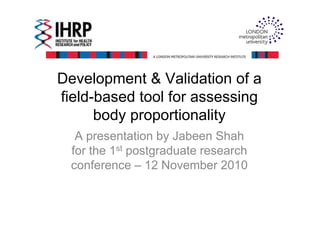Jabeen shah
- 1. Development & Validation of a field-based tool for assessing body proportionalitybody proportionality A presentation by Jabeen Shah for the 1st postgraduate research conference â 12 November 2010
- 2. Obesity epidemic âĒ Last 25 years dramatic increase in obesity- 2008 17% boys & 15% girls classed as obese; ~ 30% overweight/obese(7-9) âĒ Major risk factor for type 2 diabetes mellitus (T2DM) and cardiovascular disease(1,3, 4-6)disease(1,3, 4-6) âĒ Tackling childhood obesity Government priority(7) âĒ SAs identified as high-risk group(1, 4- 6)
- 3. Background âĒSouth Asians â genetically predisposed to central obesity, insulin resistance & type 2 diabetes, & CVD. âĒThe nature vs nurture debate
- 4. Background âĒ Anthropometry measure of growth predictor of health âĒ Growth plasticity â âThe thrifty phenotype hypothesisâ (Hales & Barker, 2001) âĒ Overweight & obesityâĒ Overweight & obesity - taller for age children (Baker et al., 2007; Buchan et al., 2007). - advanced sexual & skeletal maturity - shorter legs relative to height (Pliakas & McCarthy, 2010).
- 5. The long and the short of it! âĒShorter leg length & shorter leg length relative to height marker for CVD, type 2 diabetes, &for CVD, type 2 diabetes, & obesity (Asao et al.,2006; Bogin & Varela-Silva, 2010; Pliakas & McCarthy, 2010).
- 6. Measures of leg length âĒLeg length= Standing height - Sitting height âĒ Sitting height ratio (SHR) = (sitting(SHR) = (sitting height / height) x 100 âĒ Leg length to height ratio (LLHR) = leg length/height
- 9. Study aim âĒ To develop a valid and reliable sitting height measure for field use. âĒ Should be lightweight and portable âĒ Economical and relatively simple toâĒ Economical and relatively simple to construct.
- 11. Regular calibration with 1m rule. Results so farâĶ 1m rule. Coefficient of variation Seca = 0.1 -1.8% Adapted LHM= 0.0 â 1.1%
- 14. Conclusion âĒ The results so far suggest that the adapted measure is a valid and reliable sitting height measure that is suitable for field use.field use.














